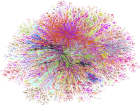Atom Versus Net
(This bit is adapted from a May 1994 essay I published in Harper’s magazine, entitled “Embrace It,” which itself was adapted from my 1994 book “Out of Control.”)
If twentieth-century science can be said to have a single icon, it is the Atom.

As depicted in the popular mind, the symbol of the Atom is stark: a black dot encircled by the hairline orbits of several smaller dots. The Atom whirls alone, the epitome of singleness. It is the metaphor for individuality. At its center is the animus, the It, the life force, holding all to their appropriate whirling station. The Atom stands for power and knowledge and certainty. It conveys the naked power of simplicity.
But the iconic reign of the Atom is now passing. The symbol of science for the next century is the dynamic Net.
The icon of the Net, in contradistinction to the Atom, has no center. It is a bunch of dots connected to other dots, a cobweb of arrows pouring into one another, squirming together like a nest of snakes, the restless image fading at indeterminate edges. The Net is the archetype displayed to represent all circuits, all intelligence, all interdependence, all things economic and social and ecological, all communications, all democracy, all groups, all large coherent systems. This icon is slippery, ensnaring the unwary in its paradox of no beginning, no end, no center.

The Net is an entity whose exact size and boundaries are unknown. All we do know is that new portions and new nodes are being added to it at such an accelerating rate that it may be more of an explosion than a thing.
The Net – like all nets — is under eternal construction, in constant flux, and of fleeting permanence. The users of the Net are creating an entirely new writing space, far different from that carved out by a printed book or even a chat around a table. Because of this impermanence, the type of thought encouraged by the Net tends toward the non-dogmatic — the experimental idea, the quip, the global perspective, the interdisciplinary synthesis, and the uninhibited, often emotional, response. Many participants prefer the quality of writing on the Net to book writing because Net writing is of a conversational, peer-to-peer style, frank and communicative, rather than precise and self-consciously literary. Instead of the rigid canonical thinking cultivated by the book, the Net stimulates another way of thinking: telegraphic, modular, non-linear, malleable, cooperative.
A person on the Net sees the world in a different light. He or she views the world as decidedly decentralized. Every far-flung member is a producer as well as a consumer, all parts of it equidistant from all others, no matter how large it gets, and every participant is responsible for manufacturing truth out of a noisy cacophony of ideas, opinions, and facts. There is no central meaning, no official canon, no manufactured consent rippling through the wires from which one can borrow a viewpoint. Instead, every idea has a backer, and every backer has an idea, while contradiction, paradox, irony, and multifaceted truth rise up in a flood.
It is no coincidence that post-modernism arose as the Network formed. In the last half-century a uniform mass market has collapsed into a network of small niches — the result of the information tide. An aggregation of fragments is the only kind of whole we now have. The fragmentation of business markets, of social mores, of spiritual beliefs, of ethnicity, and of truth itself into tinier and tinier shards is the hallmark of this era. Our society is a working pandemonium of fragments.
People in a highly connected yet deeply fragmented society can no longer rely on a central canon for guidance. They are forced into the modern existential blackness of creating their own cultures, beliefs, markets, and identities from a sticky mess of interdependent pieces. The industrial icon of a central authoritative “I” becomes hollow. Distributed, headless, emergent wholeness becomes the social ideal.
The critics of early computers capitalized on a common fear: that a Big Brother brain would watch over us and control us. What we know now of our own brains is that they too are only networks of mini-minds, a society of dumber minds linked together, and that when we peer into them deeply we find that there is no “I” in charge there either. Not only does a central-command economy not work; a central-command brain won’t either.
In its stead, we can make a nation of personal computers, a country of decentralized nodes of governance and thought. Almost every type of large-scale governance we can find, from the body of a giraffe, to the energy-regulation in a tidal marsh, to the temperature regulation of a beehive, to the flow of traffic on the Internet, resolves into a swarmy distributed net of autonomous units and heterogeneous parts.
No one has been more wrong about computerization than George Orwell in 1984. So far, nearly everything about the actual possibility-space that computers have created indicates they are not the beginning of authority but its end.
In the process of connecting everything to everything, networks of computers elevate the power of the small player. They make room for the different, and they reward small innovations. Instead of enforcing uniformity, they promote heterogeneity and autonomy. Instead of sucking the soul from human bodies, turning computer-users into an army of dull clones, networked computers — by reflecting the networked nature of our own brains and bodies — encourage the humanity of their users. Because they have taken on the flexibility, adaptability, and self-connecting governance of organic systems, we become more human, not less so, when we use them.


